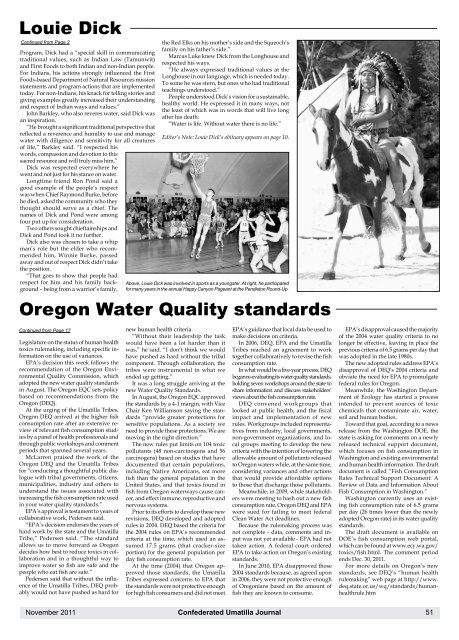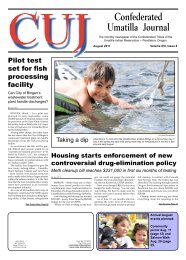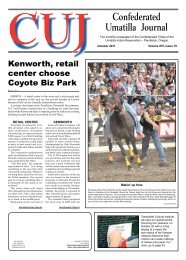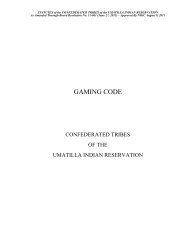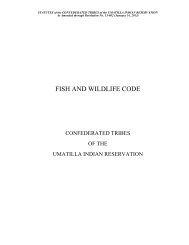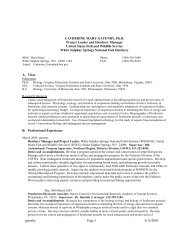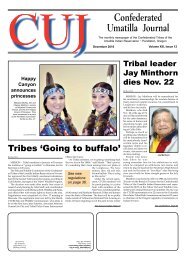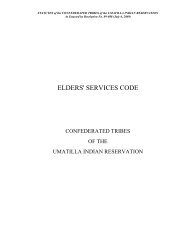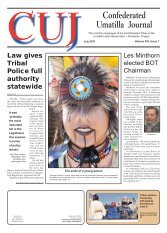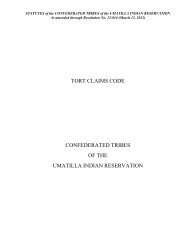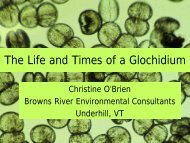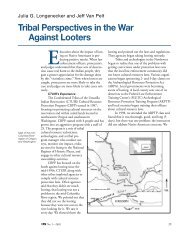November 2011 CUJ - Confederated Tribes of the Umatilla Indian ...
November 2011 CUJ - Confederated Tribes of the Umatilla Indian ...
November 2011 CUJ - Confederated Tribes of the Umatilla Indian ...
- No tags were found...
You also want an ePaper? Increase the reach of your titles
YUMPU automatically turns print PDFs into web optimized ePapers that Google loves.
Louie DickContinued from Page 2Program, Dick had a “special skill in communicatingtraditional values, such as <strong>Indian</strong> Law (Tamunwit)and First Foods to both <strong>Indian</strong> and non-<strong>Indian</strong> people.For <strong>Indian</strong>s, his actions strongly influenced <strong>the</strong> FirstFoods-based Department <strong>of</strong> Natural Resources missionstatements and program actions that are implementedtoday. For non-<strong>Indian</strong>s, his knack for telling stories andgiving examples greatly increased <strong>the</strong>ir understandingand respect <strong>of</strong> <strong>Indian</strong> ways and values.”John Barkley, who also reveres water, said Dick wasan inspiration.“He brought a significant traditional perspective thatreflected a reverence and humility to use and managewater with diligence and sensitivity for all creatures<strong>of</strong> life,” Barkley said. “I respected hiswords, compassion and devotion to thissacred resource and will truly miss him.”Dick was respected everywhere hewent and not just for his stance on water.Longtime friend Ron Pond said agood example <strong>of</strong> <strong>the</strong> people’s respectwas when Chief Raymond Burke, beforehe died, asked <strong>the</strong> community who <strong>the</strong>ythought should serve as a chief. Thenames <strong>of</strong> Dick and Pond were amongfour put up for consideration.Two o<strong>the</strong>rs sought chieftainships andDick and Pond took it no fur<strong>the</strong>r.Dick also was chosen to take a whipman’s role but <strong>the</strong> elder who recommendedhim, Winnie Burke, passedaway and out <strong>of</strong> respect Dick didn’t take<strong>the</strong> position.“That goes to show that people hadrespect for him and his family background– being from a warrior’s family,<strong>the</strong> Red Elks on his mo<strong>the</strong>r’s side and <strong>the</strong> Squeoch’sfamily on his fa<strong>the</strong>r’s side.”Marcus Luke knew Dick from <strong>the</strong> Longhouse andrespected his ways.“He always expressed traditional values at <strong>the</strong>Longhouse in our language, which is needed today.To some he was stern, but ones who had traditionalteachings understood.”People understood Dick’s vision for a sustainable,healthy world. He expressed it in many ways, not<strong>the</strong> least <strong>of</strong> which was in words that will live longafter his death:“Water is life. Without water <strong>the</strong>re is no life.”Editor’s Note: Louie Dick’s obituary appears on page 10.Above, Louie Dick was involved in sports as a youngster. At right, he participatedfor many years in <strong>the</strong> annual Happy Canyon Pageant at <strong>the</strong> Pendleton Round-Up.Oregon Water Quality standardsContinued from Page 17Legislature on <strong>the</strong> status <strong>of</strong> human healthtoxics rulemaking, including specific informationon <strong>the</strong> use <strong>of</strong> variances.EPA’s decision this week follows <strong>the</strong>recommendation <strong>of</strong> <strong>the</strong> Oregon EnvironmentalQuality Commission, whichadopted <strong>the</strong> new water quality standardsin August. The Oregon EQC sets policybased on recommendations from <strong>the</strong>Oregon (DEQ).At <strong>the</strong> urging <strong>of</strong> <strong>the</strong> <strong>Umatilla</strong> <strong>Tribes</strong>,Oregon DEQ arrived at <strong>the</strong> higher fishconsumption rate after an extensive review<strong>of</strong> relevant fish consumption studiesby a panel <strong>of</strong> health pr<strong>of</strong>essionals andthrough public workshops and commentperiods that spanned several years.McLarren praised <strong>the</strong> work <strong>of</strong> <strong>the</strong>Oregon DEQ and <strong>the</strong> <strong>Umatilla</strong> <strong>Tribes</strong>for “conducting a thoughtful public dialoguewith tribal governments, citizens,municipalities, industry and o<strong>the</strong>rs tounderstand <strong>the</strong> issues associated withincreasing <strong>the</strong> fish consumption rate usedin your water quality standards.”EPA’s approval is testament to years <strong>of</strong>collaborative work, Pedersen said.“EPA’s decision endorses <strong>the</strong> years <strong>of</strong>hard work by <strong>the</strong> state and <strong>the</strong> <strong>Umatilla</strong>Tribe,” Pedersen said. “The standardallows us to move forward as Oregondecides how best to reduce toxics in collaborationand in a thoughtful way toimprove water so fish are safe and <strong>the</strong>people who eat fish are safe.”Pedersen said that without <strong>the</strong> influence<strong>of</strong> <strong>the</strong> <strong>Umatilla</strong> <strong>Tribes</strong>, DEQ probablywould not have pushed as hard fornew human health criteria.“Without <strong>the</strong>ir leadership <strong>the</strong> taskwould have been a lot harder than itwas,” he said. “I don’t think we wouldhave pushed as hard without <strong>the</strong> tribalcomponent. Through collaboration, <strong>the</strong>tribes were instrumental in what weended up getting.”It was a long struggle arriving at <strong>the</strong>new Water Quality Standards.In August, <strong>the</strong> Oregon EQC approved<strong>the</strong> standards by a 4-1 margin, with ViceChair Ken Williamson saying <strong>the</strong> standards“provide greater protections forsensitive populations. As a society weneed to provide <strong>the</strong>se protections. We aremoving in <strong>the</strong> right direction.”The new rules put limits on 104 toxicpollutants (48 non-carcinogens and 56carcinogens) based on studies that havedocumented that certain populations,including Native Americans, eat morefish than <strong>the</strong> general population in <strong>the</strong>United States, and that toxics found infish from Oregon waterways cause cancer,and effect immune, reproductive andnervous systems.Prior to its efforts to develop <strong>the</strong>se newrevisions, DEQ developed and adoptedrules in 2004. DEQ based <strong>the</strong> criteria for<strong>the</strong> 2004 rules on EPA’s recommendedcriteria at <strong>the</strong> time, which used an assumed17.5 grams (that cracker-sizeportion) for <strong>the</strong> general population perday fish consumption rate.At <strong>the</strong> time (2004) that Oregon approvedthose standards, <strong>the</strong> <strong>Umatilla</strong><strong>Tribes</strong> expressed concerns to EPA that<strong>the</strong> standards were not protective enoughfor high fish consumers and did not meetEPA’s guidance that local data be used tomake decisions on criteria.In 2006, DEQ, EPA and <strong>the</strong> <strong>Umatilla</strong><strong>Tribes</strong> reached an agreement to worktoge<strong>the</strong>r collaboratively to revise <strong>the</strong> fishconsumption rate.In what would be a five-year process, DEQbegan re-evaluating its water quality standards,holding seven workshops around <strong>the</strong> state toshare information and discuss stakeholders’views about <strong>the</strong> fish consumption rate.DEQ convened workgroups thatlooked at public health, and <strong>the</strong> fiscalimpact and implementation <strong>of</strong> newrules. Workgroups included representativesfrom industry, local governments,non-government organizations, and localgroups meeting to develop <strong>the</strong> newcriteria with <strong>the</strong> intention <strong>of</strong> lowering <strong>the</strong>allowable amount <strong>of</strong> pollutants releasedto Oregon waters while, at <strong>the</strong> same time,considering variances and o<strong>the</strong>r actionsthat would provide affordable optionsto those that discharge those pollutants.Meanwhile, in 2009, while stakeholderswere meeting to hash out a new fishconsumption rate, Oregon DEQ and EPAwere sued for failing to meet federalClean Water Act deadlines.Because <strong>the</strong> rulemaking process wasnot complete - data, comments and inputwas not yet available - EPA had nottaken action. A federal court orderedEPA to take action on Oregon’s existingstandards.In June 2010, EPA disapproved those2004 standards because, as agreed uponin 2006, <strong>the</strong>y were not protective enough<strong>of</strong> Oregonians based on <strong>the</strong> amount <strong>of</strong>fish <strong>the</strong>y are known to consume.EPA’s disapproval caused <strong>the</strong> majority<strong>of</strong> <strong>the</strong> 2004 water quality criteria to nolonger be effective, leaving in place <strong>the</strong>previous criteria <strong>of</strong> 6.5 grams per day thatwas adopted in <strong>the</strong> late 1980s.The new adopted rules address EPA’sdisapproval <strong>of</strong> DEQ’s 2004 criteria andobviate <strong>the</strong> need for EPA to promulgatefederal rules for Oregon.Meanwhile, <strong>the</strong> Washington Department<strong>of</strong> Ecology has started a processintended to prevent sources <strong>of</strong> toxicchemicals that contaminate air, water,soil and human bodies.Toward that goal, according to a newsrelease from <strong>the</strong> Washington DOE, <strong>the</strong>state is asking for comments on a newlyreleased technical support document,which focuses on fish consumption inWashington and existing environmentaland human health information. The draftdocument is called “Fish ConsumptionRates Technical Support Document: AReview <strong>of</strong> Data and Information AboutFish Consumption in Washington.”Washington currently uses an existingfish consumption rate <strong>of</strong> 6.5 gramsper day (26 times lower than <strong>the</strong> newlyadopted Oregon rate) in its water qualitystandards.The draft document is available onDOE’s fish consumption web portal,which can be found at www.ecy.wa.gov/toxics/fish.html. The comment periodends Dec. 30, <strong>2011</strong>.For more details on Oregon’s newstandards, see DEQ’s “human healthrulemaking” web page at http://www.deq.state.or.us/wq/standards/humanhealthrule.htm<strong>November</strong> <strong>2011</strong><strong>Confederated</strong> <strong>Umatilla</strong> Journal51


